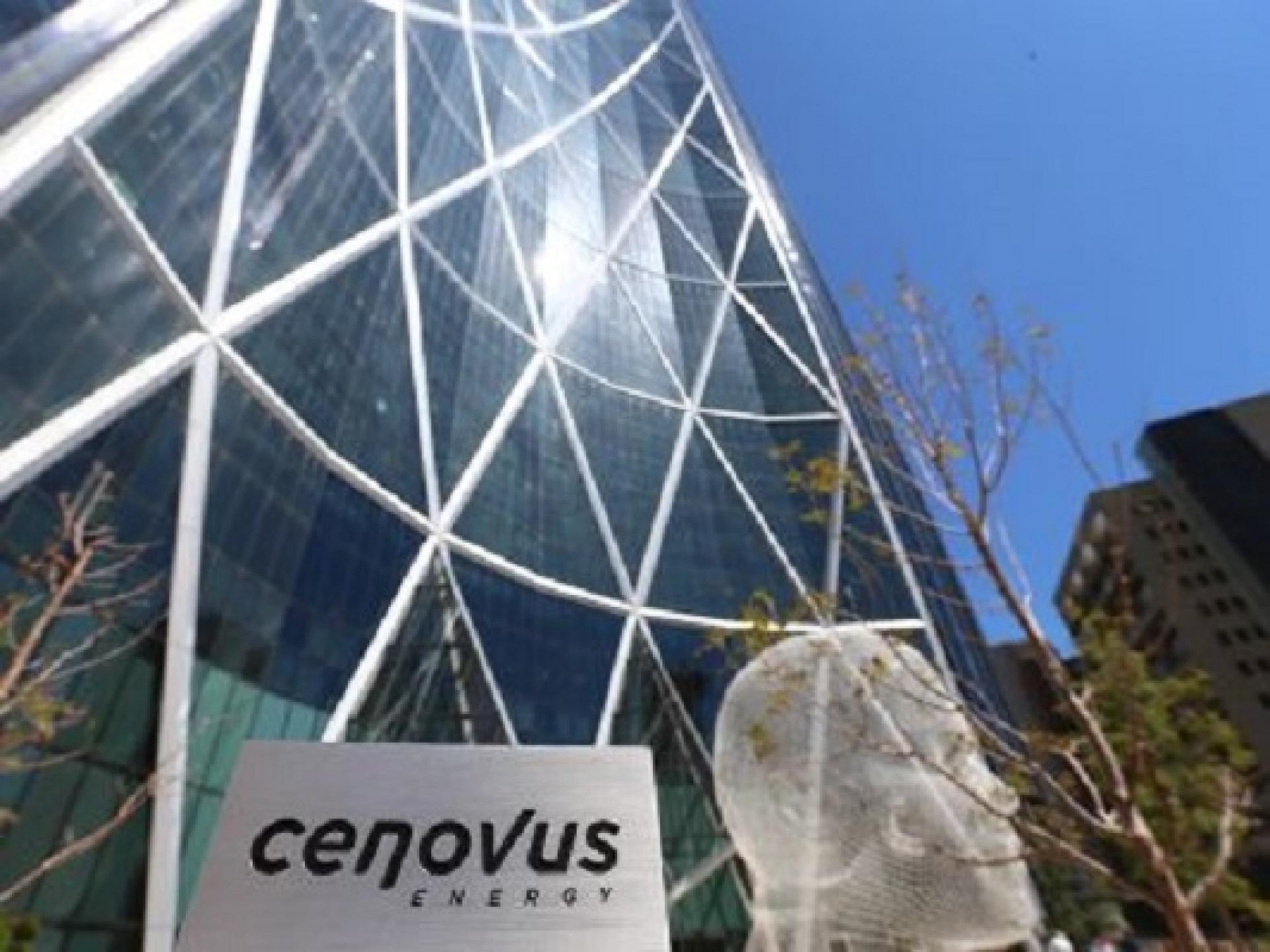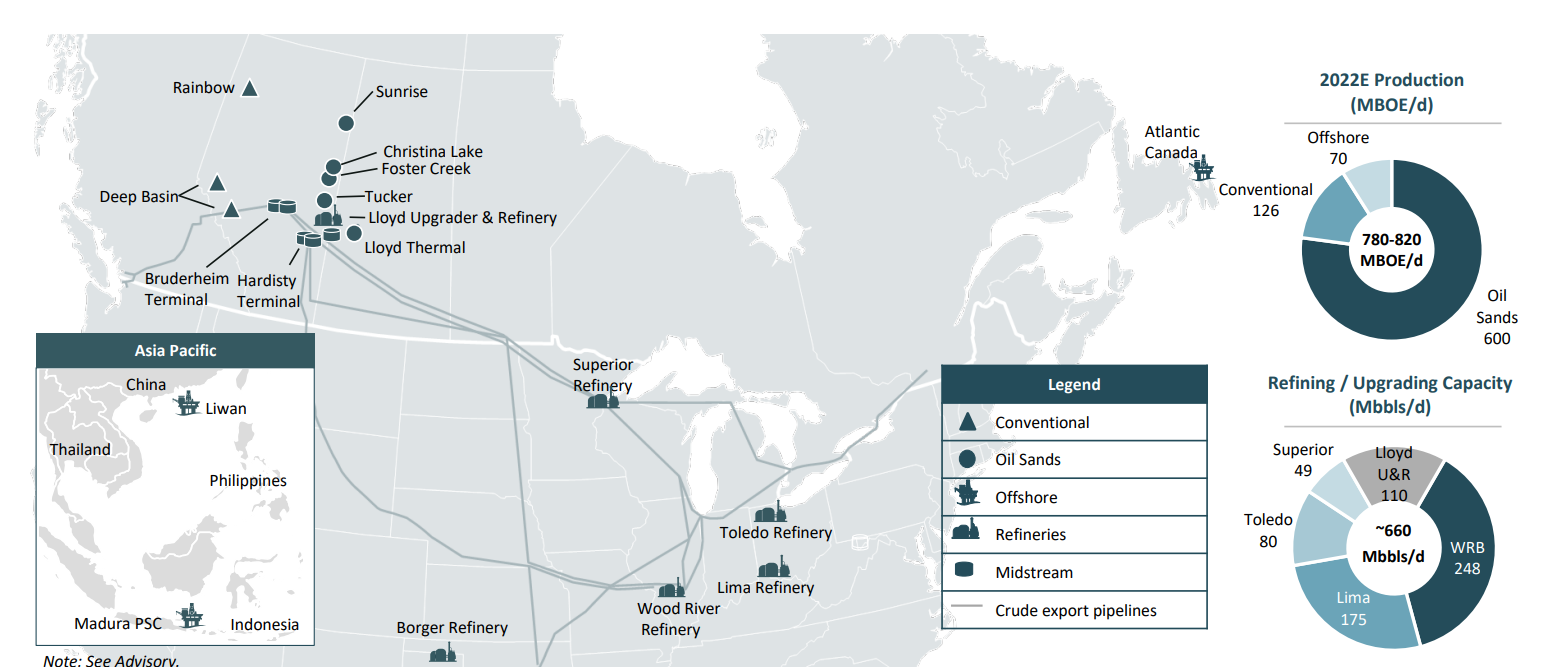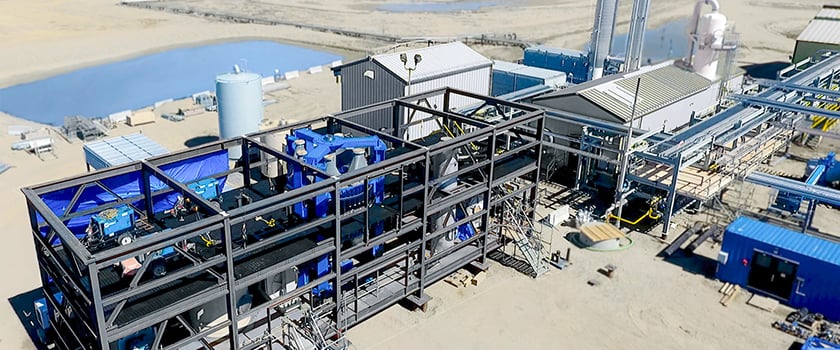Cenovus Energy
Summary
- Cenovus Energy is a Canadian-based integrated energy company headquartered in Calgary
- The company operate in Canada, the United States and the Asia Pacific region
- Its's operations include oil sands projects in northern Alberta, thermal and conventional crude oil and natural gas projects across Western Canada, crude oil production offshore Newfoundland and Labrador and natural gas and liquids production offshore China and Indonesia.
- Cenovus markets crude oil, natural gas, natural gas liquids, asphalt, petroleum coke and sulphu
- On January 1, 2021 Cenovus Energy acquired Husky Energy

Company Overview
Cenovus Energy (NYSE:CVE, TSX:CVE) is a Canadian-based integrated energy company headquartered in Calgary. The company committed to maximizing value by sustainably developing its assets in a safe, innovative and cost-efficient manner, integrating environmental, social and governance considerations into its business plans.1

The company operate in Canada, the United States and the Asia Pacific region. The company's operations include oil sands projects in northern Alberta, thermal and conventional crude oil and natural gas projects across Western Canada, crude oil production offshore Newfoundland and Labrador and natural gas and liquids production offshore China and Indonesia. Cenovus’s downstream operations include upgrading, refining and marketing operations in Canada and the United States.
On January 1, 2021 Cenovus Energy acquired Husky Energy. The combined company is the third largest Canadian oil and natural gas producer and the second largest Canadian-based refiner and upgrader.

Products
Cenovus markets crude oil, natural gas, natural gas liquids, asphalt, petroleum coke and sulphur. It markets and distributes gasoline, diesel, jet fuel, asphalt, lubricants and ancillary products.2
- Asphalt
- Crude oil
- Dried distillers grain with solubles
- Drilling and completion fluids
- Ethanol
- Gasoline
- Lubricants
- Heavy fuel oil and bunker fuels
- Mining applications
- Cavern development
- Natural gas liquids (NGLs)
- Natural gas
- Petroleum coke
- Refinery feedstocks
- Sulphur

Operations
On January 1, 2021 Cenovus Energy acquired Husky Energy. The combined company is the third largest Canadian oil and natural gas producer, the second largest Canadian-based refiner and upgrader, and unites high-quality and low-cost oil sands and heavy oil assets with extensive midstream and downstream infrastructure.3
Conventional
Cenovus Energy has conventional oil and natural gas assets across Alberta and northeastern British Columbia.
Heavy oil
The majority of its thermal heavy oil assets are located in Saskatchewan and Alberta.
The company's value chain
The company develop, transport, produce and market crude oil and natural gas.
Oil sands
The company has been operating in Alberta’s oil sands for more than two decades. All of its oil sands projects use a drilling method called steam-assisted gravity drainage or SAGD for short. Cenovus Energy has no mining assets, no tailings ponds and no megaprojects.
Cenovus Energy has three producing oil sands projects — Christina Lake, Foster Creek and Sunrise – as well as regulatory approval for future oil sands development projects, including its 100 percent-owned Narrows Lake and Telephone Lake assets.
The company use a repeatable, manufacturing approach to build these projects, and the company develop them in phases — allowing it to learn and adapt from one phase to the next. Each successive phase benefits from improved technology that results in operational efficiencies and a reduced environmental footprint.
- Christina Lake
- Foster Creek
- Sunrise
Offshore
Cenovus Energy has operations and exploration prospects offshore in the Asia Pacific region and Newfoundland and Labrador.
- China
- Indonesia
- Atlantic

Oil and Gas Reserves
As at December 31, 2021 (before royalties) | Bitumen (MMbbls) | Light and Medium Oil (MMbbls) | NGLs (MMbbls) | Conventional Natural Gas (Bcf) | Total (MMBOE) |
| Total Proved | 5,573 | 45 | 89 | 2,219 | 6,077 |
| Probable | 1,850 | 152 | 39 | 959 | 2,201 |
| Total Proved Plus Probable | 7,423 | 197 | 128 | 3178 | 8278 |

Financial Highlights
Cenovus Energy Inc. delivered record oil sands production in the fourth quarter of 2021, contributing to total upstream output of more than 825,000 barrels of oil equivalent per day (BOE/d) and almost 792,000 BOE/d for the full year. The company generated fourth-quarter cash from operating activities of $2.2 billion and adjusted funds flow of $1.9 billion. With free funds flow of $1.1 billion in the quarter, and proceeds from recent divestitures, net debt was below $9.6 billion at year end, a reduction of more than $1.4 billion from the end of the third quarter and $3.5 billion in 2021 following the acquisition of Husky Energy. Total long-term debt was $12.4 billion as at December 31, 2021, down nearly $1.7 billion from January 1, 2021, and expected to decrease by approximately US$384 million on February 9 when Cenovus redeems the remaining principal amount of its notes due in 2023 and 2024. As part of its plan to enhance shareholder returns, Cenovus continues to buy back common shares under its previously announced Normal Course Issuer Bid (NCIB) and as of February 7 had repurchased approximately 26 million common shares at a volume weighted price of $16.31 per share.4
“In its first year as a combined company the company delivered exceptional operational performance at its upstream business, successfully integrated the assets acquired in the Husky transaction and aggressively reduced debt, creating a stronger company,” said Alex Pourbaix, Cenovus President & Chief Executive Officer. “The company exceeded its expected transaction synergies and enhanced shareholder returns, doubling its quarterly dividend and commencing its share buyback program. In addition, we’re well positioned to consider future opportunities to further enhance returns for its shareholders.”
Fourth quarter operating results
In the fourth quarter, Cenovus achieved upstream production of 825,300 BOE/d, including record average daily oil sands production of almost 251,000 barrels per day (bbls/d) at Christina Lake and nearly 212,000 bbls/d at Foster Creek. Christina Lake production added more than 8,000 bbls/d compared with the third quarter, benefiting from the continued success of Cenovus’s well redevelopment plan. Production at Foster Creek increased almost 25,000 bbls/d from the previous quarter, primarily due to new wells from the asset’s west development area now operating at full production rates. The Lloydminster thermal projects continued to demonstrate strong and reliable performance, achieving production of 99,000 bbls/d, up from 98,000 bbls/d in the third quarter. The Offshore segment contributed more than 73,000 BOE/d, including production of 62,500 BOE/d from the Asia Pacific region and 10,600 bbls/d from the Atlantic region, while the Conventional segment had production of 125,300 BOE/d.
The Canadian Manufacturing segment also continued its strong and reliable performance. The crude utilization rate was 98%, with the Lloydminster Upgrader and Lloydminster Refinery running at or near capacity throughout the fourth quarter. Canadian Manufacturing throughput was 108,300 bbls/d, in line with the third quarter.
In the U.S. Manufacturing segment, the crude utilization rate was 72% with crude throughput of 361,600 bbls/d, down from 89% utilization and throughput of 445,800 bbls/d in the third quarter. The difference in the fourth quarter was primarily due to reduced throughput at the Lima Refinery related to a planned major turnaround, which occurs every five years, as well as subsequent operational challenges on secondary units at Lima, as well as planned maintenance and an unplanned outage at the Wood River Refinery, co-owned with operator Phillips 66. The challenges following completion of the Lima turnaround reduced throughput in December and most of January. These issues have been successfully resolved and the Lima facility returned to normal operations by the end of last month.
“In 2021, the company clearly delivered on its operational strength in the Upstream and Canadian Manufacturing businesses,” said Pourbaix. “In 2022, Cenovus Energy is focused on building a similarly strong executional track record in U.S. Manufacturing and demonstrating the additional value that business will generate for its shareholders.”
In the fourth quarter, Cenovus’s total revenues were slightly over $13.7 billion compared with $12.7 billion in the third quarter, driven by higher average realized sales prices for the company’s products across the Upstream and Downstream segments. Total operating margin for the quarter was $2.6 billion, compared with approximately $2.7 billion in the previous quarter, driven primarily by reduced throughput and higher costs in U.S. Manufacturing.
Downstream revenues rose to about $8.1 billion compared with $7.5 billion in the third quarter, largely driven by higher average refined product pricing. Total Downstream operating margin fell to $42 million compared with $268 million in the third quarter, largely due to the elevated operating costs in U.S. Manufacturing offset by continued strong and reliable operating performance from Canadian Manufacturing. While Canadian Manufacturing operating margin of $131 million was relatively flat with the previous quarter’s $130 million, U.S. Manufacturing operating margin was negative $97 million, down from $122 million in the third quarter.
Upstream revenues rose to $7.4 billion from $6.6 billion in the previous quarter, driven by higher average realized sales prices. Total Upstream operating margin was more than $2.5 billion, up slightly from about $2.4 billion in the third quarter, with the difference mainly driven by higher operating margins from the company’s Conventional and Offshore assets. In both cases, the operating margin increases were primarily driven by higher average realized sales.
Fourth quarter financial results
Cash from operating activities was $2.2 billion and adjusted funds flow was $1.9 billion in the quarter. Free funds flow of $1.1 billion included capital investment of $835 million primarily for planned winter drilling programs in the Oil Sands and Conventional segments as well as the Superior Refinery rebuild project.
Cash flows were impacted in the fourth quarter by a realized risk management loss of $268 million related to Cenovus’s inventory risk management program compared with a realized risk management loss of $184 million in the third quarter. In addition, general and administrative expense was $358 million, compared with $158 million in the prior quarter, with the quarter-over-quarter change related to an accrual of $167 million for a synergies incentive plan as well as $62 million for the impact of increased share price on stock-based compensation expense.
Cenovus recorded a net loss of $408 million in the fourth quarter, compared with third-quarter net earnings of $551 million. The net loss primarily resulted from a non-cash impairment of $1.9 billion in the U.S. Manufacturing segment, reflecting a point-in-time commodity price outlook for accounting purposes, partially offset by reversals of prior impairments of $378 million in Cenovus’s Conventional segment. The company continues to see long-term value in the U.S. Manufacturing business, including the reduced cash flow volatility offered by Cenovus’s integrated heavy oil value chain.
Full-year results
On a full-year basis, Cenovus achieved total Upstream production of 791,500 BOE/d, reflecting production increases at most of the company’s assets, including record output in its Oil Sands segment over the course of the year. Total Oil Sands segment production was 581,500 bbls/d, including nearly 180,000 bbls/d at Foster Creek, a 10% increase from 2020, and about 237,000 bbls/d at Christina Lake, up 8% from the previous year. Record production was also delivered at the Lloydminster thermal projects with almost 98,000 bbls/d for the year. In Conventional, production increased to 133,600 BOE/d from approximately 89,900 BOE/d in 2020, with the increase largely related to assets acquired through the Husky transaction. Offshore total production was 74,400 BOE/d.
In Canadian Manufacturing, average utilization for the year was 96% and average throughput was 106,500 bbls/d, reflecting the top-tier performance of the Lloydminster Upgrader and Lloydminster Refinery. In U.S. Manufacturing, full-year utilization was 80% and average throughput was 401,500 bbls/d.
Total revenues were about $46.4 billion in 2021 and total operating margin was almost $9.4 billion, compared with revenues of $13.5 billion and total operating margin of $921 million in 2020. Year over year differences in both total revenues and total operating margin largely related to increased commodity prices and assets acquired in the Husky transaction.
Cash from operating activities was nearly $6 billion for the year, compared with $273 million in 2020. Adjusted funds flow was $7.2 billion and free funds flow was $4.7 billion. Total capital expenditures for the year were approximately $2.6 billion, primarily concentrated on sustaining production at the company’s upstream assets and maintenance capital for the downstream assets, as well as investment in the Superior Refinery rebuild. Full-year net earnings for 2021 were $587 million compared with a loss of $2.4 billion the previous year.